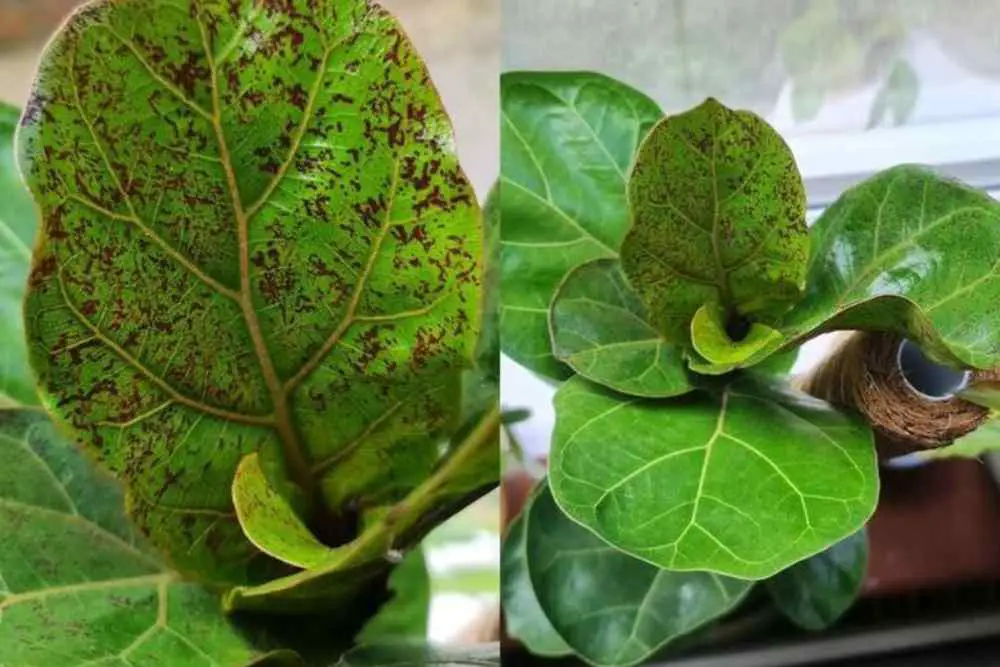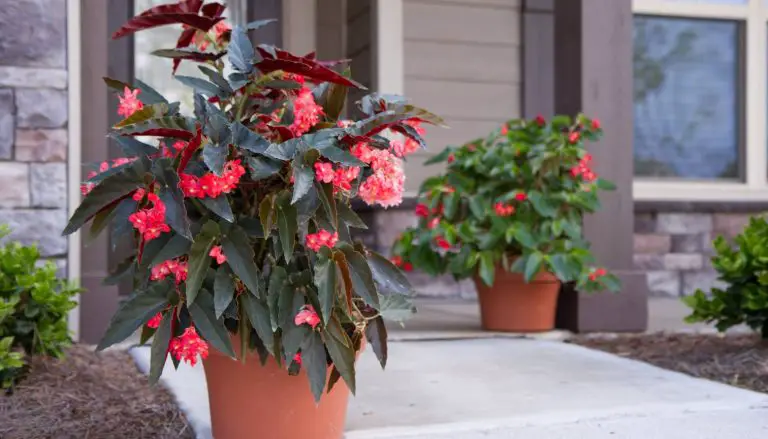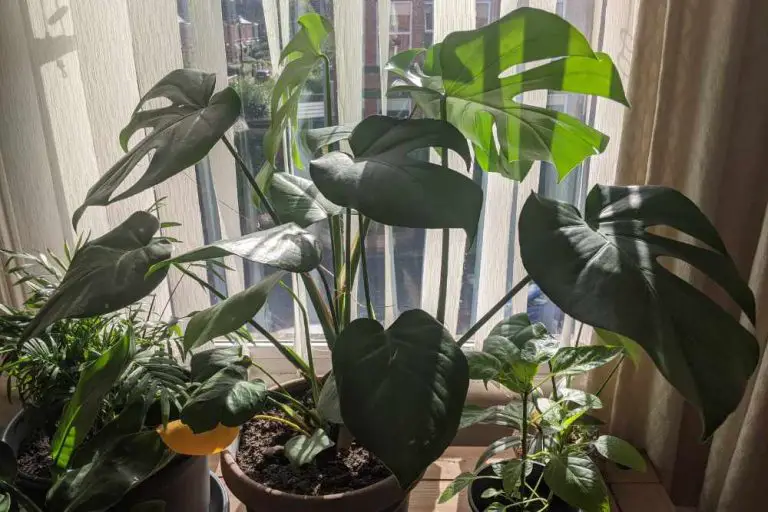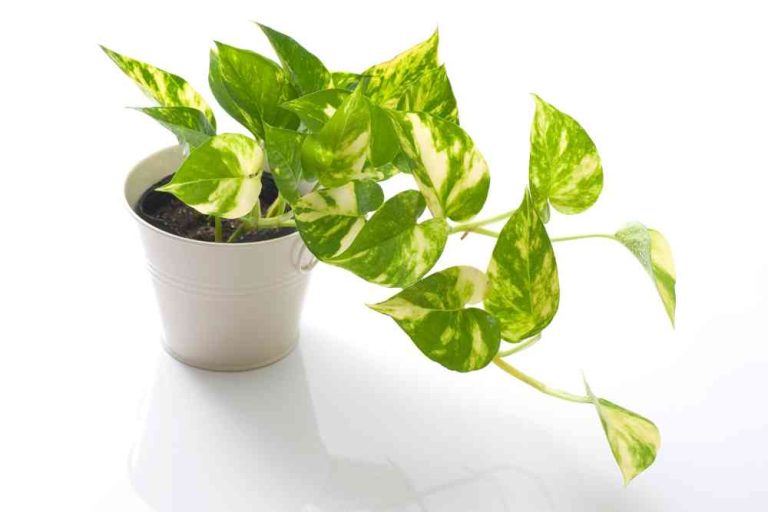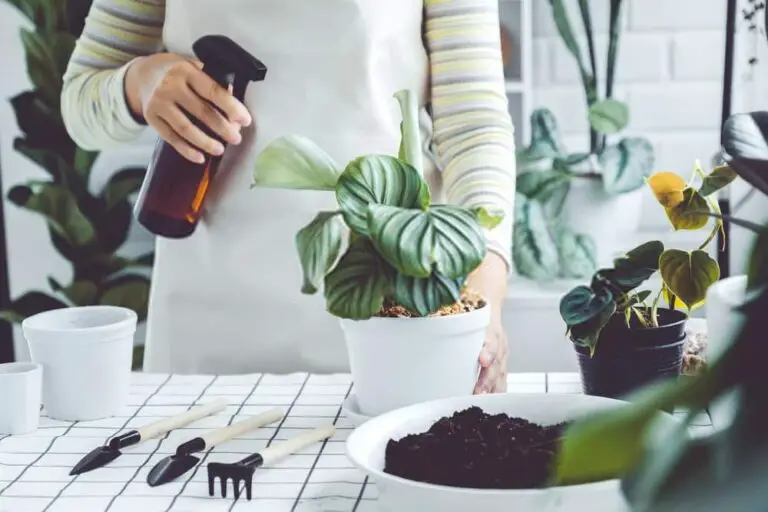How to Treat Brown Spots on Fig Leaves: Effective Treatment Methods
Beautiful small fiddle-leaf fig trees (Ficus lyrata) make wonderful houseplants. In the correct circumstances, they are simple to maintain and an excellent option to add a touch of nature to your house.
Your fiddle-leaf fig leaves may occasionally have brown stains on them. Especially for novice gardeners, this might be troubling. A variety of reasons can cause those spots, but there are simple techniques to determine what is to blame. Knowing the reason will enable you to treat the issue appropriately. Knowing the causes and how to treat brown spots on fig leaves will help you handle the problem properly.
What Causes Brown Spots on Fiddle Leaf Fig Leaves?
There are a few basic reasons for brown spots on the fiddle leaf fig leaves. Insect infestations, sunburn, dryness, or bacterial or fungal root rot are a few examples. The spots’ location, color, and spread might help you make a more precise diagnosis.
Although fiddle leaf figs are generally hardy, it is recommended to watch for any symptoms of diseases. Your fiddle leaf fig may be suffering from a number of different illnesses, as indicated by the brown spots on it. Leaving fiddle leaf fig leaves untreated may cause them to gradually fall off, which could possibly be harmful to the health of your plants.
You can determine the precise issue your plant is having by closely examining your leaves. You can learn more about the problem at hand by examining the color, size, and spread of the brown spots and smelling the soil where your fig grows. Pest infestations can also cause damage to fiddle leaf figs.
1. Sunburn
Your fiddle leaf fig may have sunburn if your indoor plant was unexpectedly exposed to a lot of sunlight. Although it doesn’t happen very often, it does occasionally cause spots on the upper outer leaves of your plant that are light tan. Depending on the amount of exposure the plant has received, sunburnt regions can range in size from a dime to a baseball.
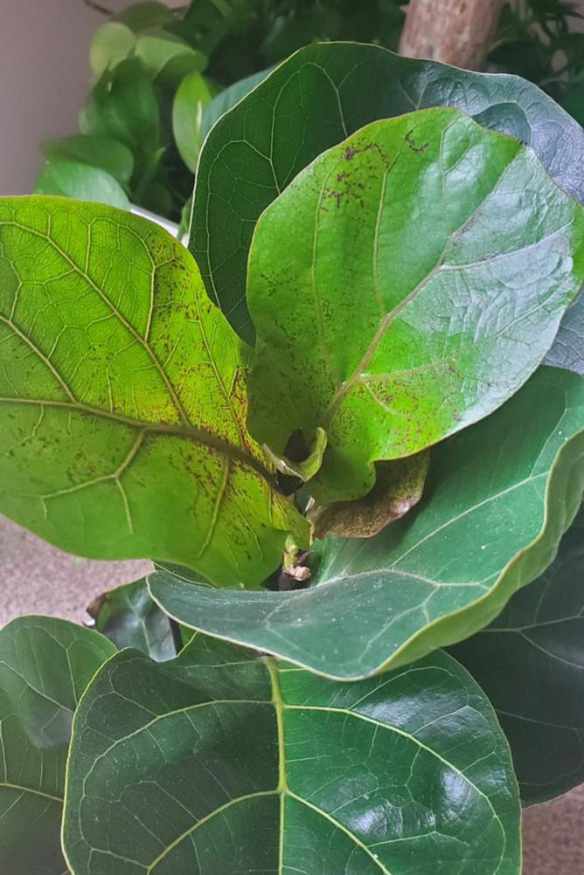
The burnt sections will not recover, but they may be removed without causing more damage to the plant. Indirect bright sunlight will benefit your tree’s growth. Exposure to the sun’s strong rays during the day causes leaf burn. This phenomenon is most likely to occur on the highest leaves of fiddle-leaf figs.
In addition to color loss or bleaching, sunburn can manifest itself in several ways on leaves. Leaves that have been exposed to the sun may be light brown, white, or yellow. Your tree’s dark spots can appear crisp and have a yellow circle encircling its edge. The entire leaf is coated with irregular light brown dots.
2. Bacterial root rot
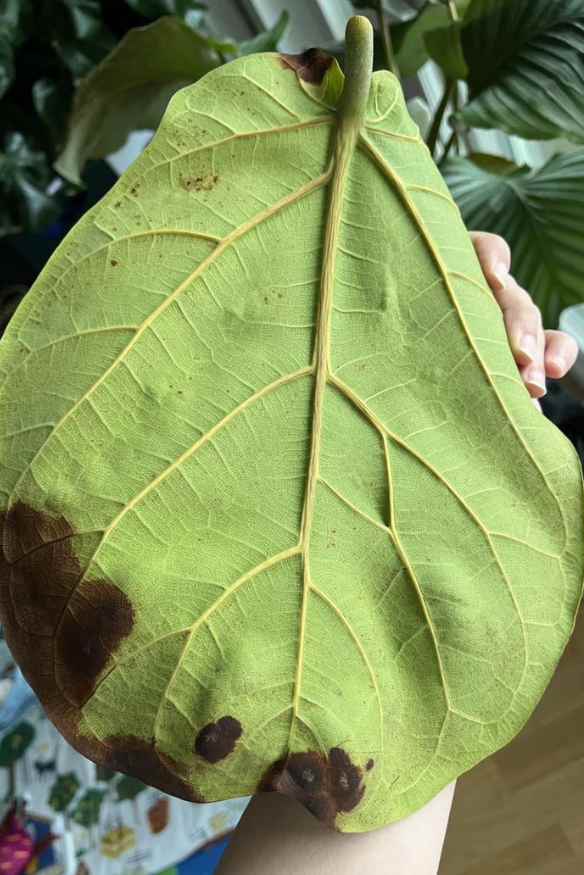
Bacterial root rot appears as dark brown, erratic-shaped dots around the border of your fig leaves. Your leaves may start to crack where they have become brown in the later stages of infestation. Bacterial root rot develops in soil that has been overwatered or is waterlogged, typically due to inadequate drainage and insufficient aeration.
Brown spots on fiddle leaf figs typically appear on the bottom leaves of older growth, which makes it simple to notice them. You might believe your fiddle leaf fig has red spots, not brown ones, since a light, rust-colored region may form on the underside of the plant’s leaves at the onset of a bacterial infection. Bacterial infections, regardless of color, spread rapidly and must be treated as soon as possible.
3. Overwatering
Your fiddle leaf fig is one of several indoor plants that frequently experience overwatering or root rot. If the compost remains damp for an extended period, it can develop a fungal infection. This scenario will gradually deplete the tree’s roots. It might be disastrous if not discovered quickly enough.
Root rot can be identified by discolored leaves or by highly black or dark brown patches that gradually spread across the foliage. They will be most affected because they normally start with the lower, older leaves. When overwatering occurs deeper inside the tree, these patches will start at the base of the leaves, where it meets the stems, and expand outward. The outer parts of the tree may develop brown patches due to root rot. The leaves will fall off if the situation is not handled.
4. Underwatering
The fiddle leaf fig leaves on your plant may be turning brown and crackling, starting at the borders and progressing to the point where they fall off. This condition could be a sign of underwatering, especially if it is restricted to the plant’s base.
Identify the problem and make the appropriate corrections if the irrigation schedule functions properly. Depending on the season, plants need varying amounts of water. Throughout the year, the amount of water in it fluctuates. Weekly tree watering may sound practical, but a lot will depend on where you live.
5. Fungal Root Rot

Similar to bacterial root rot in appearance, fungal root rot typically has darker, nearly black patches. Additionally, they often grow from the leaf veins, tending to grow more in the middle of the leaf rather than the edges.
An overwatered fiddle leaf fig is the root of the problem with fungal root rot. The roots of the fig plants become infected by fungal spores that grow in the soil around the plants, killing the plants. If the roots of your fiddle have gone brown and mushy, you almost certainly have root rot.
6. Insect infestation
Brown spots may also form on a fiddle leaf fig when insects are present; however, these spots are typically followed by tears or small holes in the leaves. In order to identify an insect infestation, check for evidence of small creatures climbing over your plant, leftover webs, or insect eggs. The technique of treating an insect infestation can be relatively straightforward since getting rid of the insects and removing harmed leaf materials should solve the issue.
Root rot spots are darker than insect spots, which don’t spread on their own. Your fiddle leaf fig tree may have bug infestations if it has brown spots on it. To survive, they consume the plant’s juices. Unfortunately, the extreme infestation may cause some issues. There are many different kinds of plant pests. The most typical suspects include
Aphids: These tiny, green, or black insects are pests. Especially if your tree spends the summer outdoors, these are very common.
Mealybugs: Due to their stubborn nature, they are the most hated of all insects. They resemble little white spots that are fuzzy in appearance. They like the region of the plant where the leaves and stems converge.
Spider mites: These microscopic pests resemble moving dots because of their size. They do not enjoy dampness. To prevent them, it is advisable to raise the humidity.
Fungus gnats: Your tree may struggle to maintain its leaves since their larvae like to eat plant roots.
How To Treat Brown Spots On Fig Leaves?
It is important to take care of any brown spots on your fiddle leaf fig leaves as soon as you notice them. For optimal outcomes, take into account the following option:
– How should a sunburned fiddle leaf fig be treated?
Remove your fiddle leaf from the sun to prevent sunburn before treating it. In order to keep your plant from wasting energy trying to recover burned leaves, trim them next. The fiddle leaf plant can also benefit from a little extra moisture and increased humidity in its growth environment. Fiddle leaf figs may first appear as though they are only somewhat harmed by solar exposure. But it can seriously harm your plant’s health.
Ficus large, waxy green leaves are particularly vulnerable to sun damage; therefore, they shouldn’t be exposed to too much intense, direct sunshine. The first sign that your fiddle leaf fig needs to be moved or shaded is the appearance of brown patches on the upper leaves.
The best thing you can do for a sun-damaged fiddle leaf is to prune the damaged area away with sterile, sharp shears. Unfortunately, burnt leaves won’t grow back. Removing too many damaged leaves might result in deadly suffering; therefore, if several leaves are injured, only remove the worst ones. After that, give your plant more water and humidity so its cells can rehydrate. Keep it in an east-facing window so that it receives six to eight hours of daylight each day but not the intense afternoon sun.
– Bacterial infection fiddle leaf fig treatment
The most difficult plant health issue to manage is bacterial infestation. The treatment is the same as what is used to treat root rot. After watering:
- Ensure your tree’s roots are dry, and ensure it receives enough sunlight.
- Replace the old pot with one that has excellent drainage and fresh, hygienic soil if the infection is minimal.
- Remove all leaves that have brown spots on them.
- For the duration of its recovery, give it only a small amount of moisture and good sunlight.
Placing your plant outside in the shade to recover could be a good alternative to treatment, depending on the surroundings. Your Fiddle Leaf Fig can recover faster with sunshine, fresh air, and comfortable temperatures.
– Eliminate Insects
Neem oil might be quite efficient at getting rid of pests. Dish soap and water will substitute this oil if you don’t have any at home. Bug traps and lint rollers are two other techniques that can be useful. Examine the area once a week to see if the bug infestation has returned.
– Deal with drainage
Root rot causes dark brown patches on plants. So you must find a solution to this issue to rescue your plant. You must address the problem immediately because poor drainage frequently results in root rot. Make sure to choose a pot with good drainage, quick-draining gardening soil, and avoid overwatering.
If you’re not sure whether the roots of your tree get wet, you can use a moisture meter to find out. Finding out how much damage there is is the next step. If the browning of the leaf is limited to a few spots, you don’t need to replace the container for your tree.
– Removing damaged leaves
Damaged leaves should be removed in order to aid in the recovery of your plant and stop the spread of brown spots. Over 50% browning of a leaf indicates that it cannot be preserved and must be removed. But keep in mind that it would take much longer for your plant to recover if you remove more than 50% of it altogether, which could result in a fiddle leaf fig with no leaves.
– Replace the soil
Replacing the soil is good because well-draining, well-aerated soil is optimal for fiddle leaf figs. Repotting is the solution for brown stains on plants.
how to prevent brown spots on a fiddle leaf fig?
You can take a few preventative steps to protect your fiddle leaf fig from brown spots. Most of these are simple tasks that will keep your plant healthy all year long.
Don’t underwater it
A dry environment might also result in brown stains on your fiddle leaf fig, so avoid submerging it in water. Insert your fingers and check the top inch or so to see if the soil is damp to gauge the soil’s moisture content.
Avoid overwatering your fiddle leaf fig
Avoid intense direct sunlight by protecting your fiddle leaf fig from it. These beautiful plants definitely enjoy the sun, but they perform best in locations with east-facing sunlight that isn’t too direct or intense. A bright east-facing window provides the light that fiddle leaf figs need indoors.
Ensure it has good drainage
Make sure it has good drainage. The Ficus lyrata requires good drainage. This is why a planter with well-spaced, large drainage holes at the bottom is preferable for your fiddle leaf fig. Consider coating the base with gravel to distribute excess moisture more evenly.
Re-pot your fiddle leaf fig
Repotting your fiddle leaf figs once or twice a year will maintain the soil’s quality and keep them expanding relative to their planters. Fungi can be effectively controlled with a fresh application of soil.
- 20+ Chic Boho Bedroom Ideas for a Cozy and Stylish Retreat - June 20, 2024
- 12+ Modern Boho Living Room Ideas to Create a Unique Oasis - June 10, 2024
- 10 Stunning Canopy Bed Ideas for a Dreamy Escape - May 16, 2024

